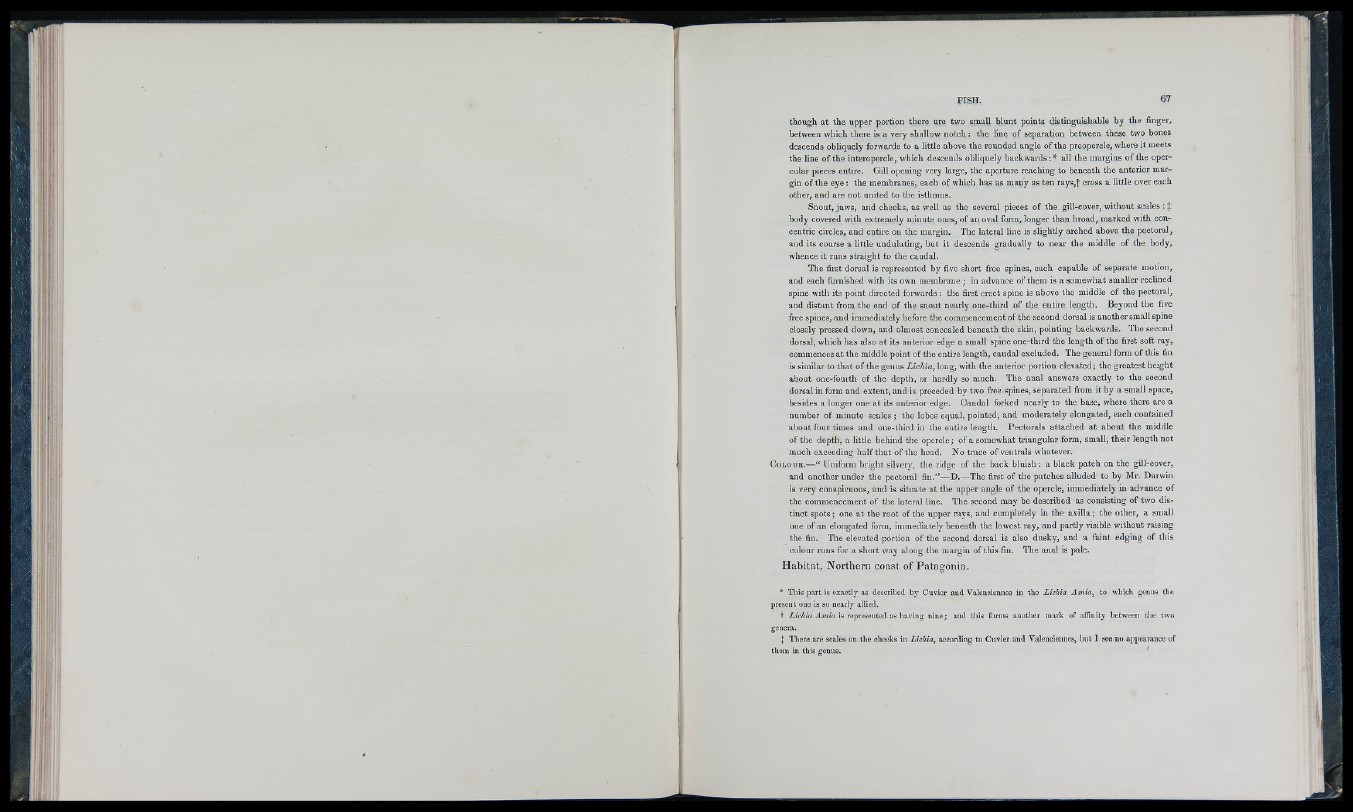
p i i
ili
though a t the upper portion there are two small blunt points distinguishable by the finger,
between which there is a very shallow n o tch : the line of separation between these two bones
descends obliquely forwards to a little above the rounded angle of the preopercle, where it meets
the line of the interoperele, which descends obliquely backwards :* all the margins of the opercular
pieces entire. Gill opening very large, the aperture reaching to beneath the anterior margin
of the eye : the membranes, each of which has as many as ten rays,f cross a little over each
other, and are not united to the isthmus.
Snout, jaw s, and cheeks, as well as the several pieces of the gill-cover, without scales : %
body covered with extremely minute ones, o f an oval form, longer than broad, marked with concentric
circles, and entire on the margin. The lateral line is slightly arched above the pectoral,
and its course a little undulating, but it descends gradually to near the middle of the body,
whence it runs straight to the caudal.
The first dorsal is represented by five short free spines, each capable of separate motion,
and each furnished with its own membrane ; in advance of them is a somewhat smaller reclined
spine with its point directed forwards : the first erect spine is above the middle of the pectoral,
and distant from the end o f the snout nearly one-third of the entire length. Beyond the five
free spines, and immediately before the commencement of the second dorsal is another small spine
closely pressed down, and alm ost concealed beneath the skin, pointing backwards. The second
dorsal, which has also at its anterior edge a small spine one-third the length of the first soft ray,
commences a t the middle point of the entire length, caudal excluded. The general form of this fin
is similar to that o f the genus L ichia, long, with the anterior portion elevated; the greatest height
about one-fourtli of the depth, or hardly so much. The anal answers exactly to the second
dorsal in form and extent, and is preceded by two free spines, separated from it by a small space,
besides a longer one at its anterior edge. Caudal forked nearly to the base, where there are a
number of minute scales; the lobes equal, pointed, and moderately elongated, each contained
about four times and one-third in the entire length. Pectorals attached a t about the middle
of the depth, a little behind the opercle; of a somewhat triangular form, small, their length not
much exceeding half that of the head. No trace of ventrals whatever.
C o l o u r .— “ Uniform bright silvery, the ridge of the back b lu ish : a black patch on the gill-cover,
and another under the pectoral fin.”— D.—The first of the patches alluded to by M r. Darwin
is very conspicuous, and is situate at the upper angle of the opercle, immediately in advance of
the commencement of the lateral line. The second m ay be described as consisting of two distinct
spots; one at the root of the upper rays, and completely in the axilla; the other, a small
one of an elongated form, immediately beneath the lowest ray, and partly visible without raising
the fin. The elevated portion of the second dorsal is also dusky, and a faint edging of this
colour runs for a short way along the margin of this fin. The anal is pale.
H abitat, Northern coast of Patagonia.
* This part is e.xactly as described by Cuvier aud Valenciennes in the Lichia Amia, to which genus the
present one is so nearly allied.
•t iic/iid is represented as having nine; and this forms another mark of affinity between the two
genera.
i There are scales on the checks in Lichia, according to Cuvier and Valenciennes, but I see no appearance of
them in this genus.